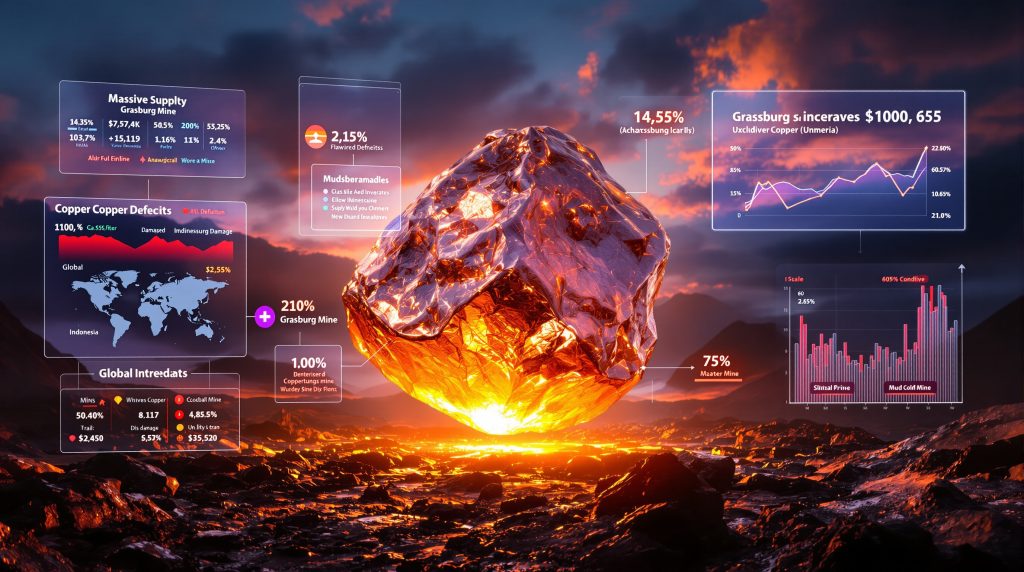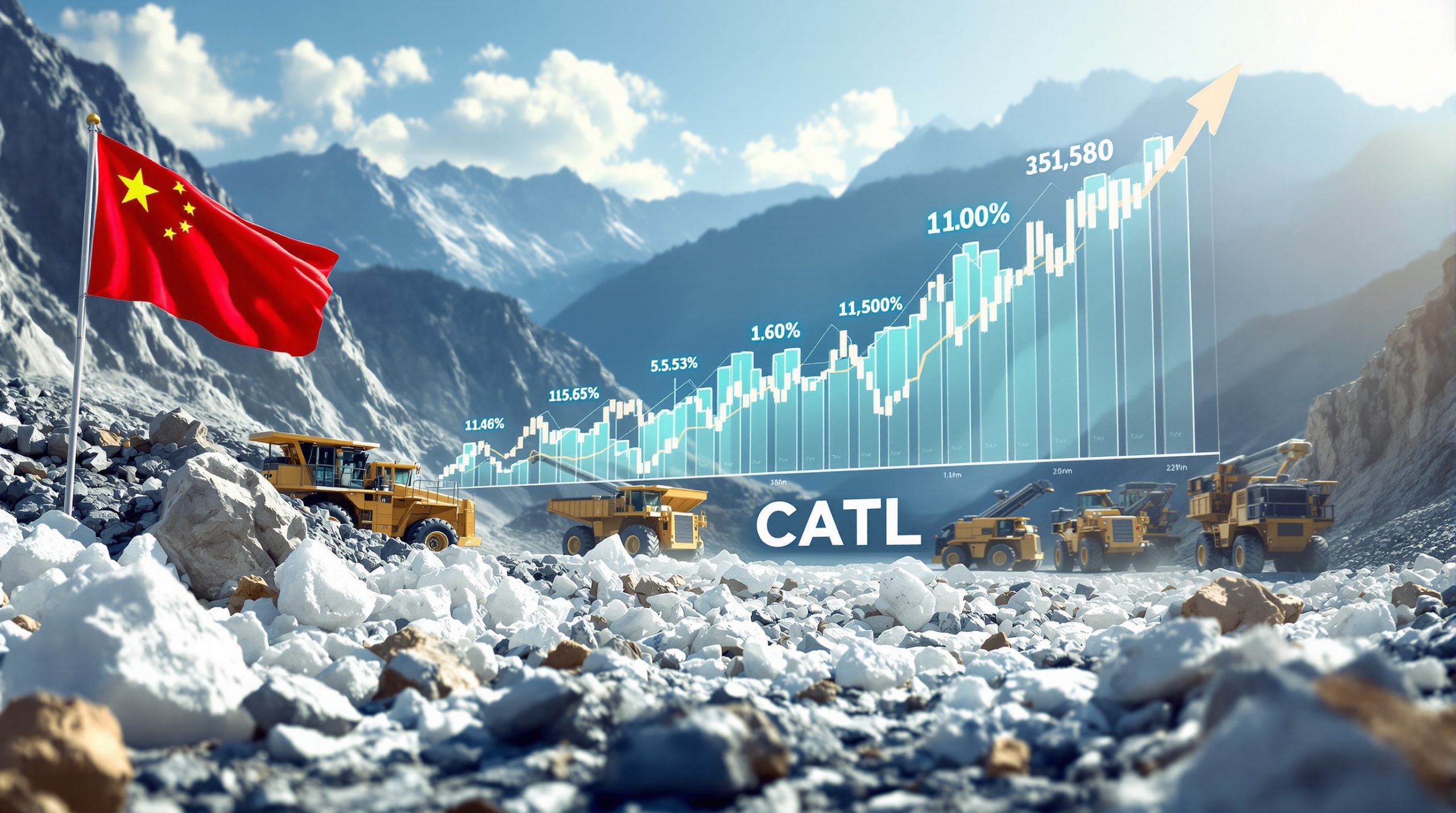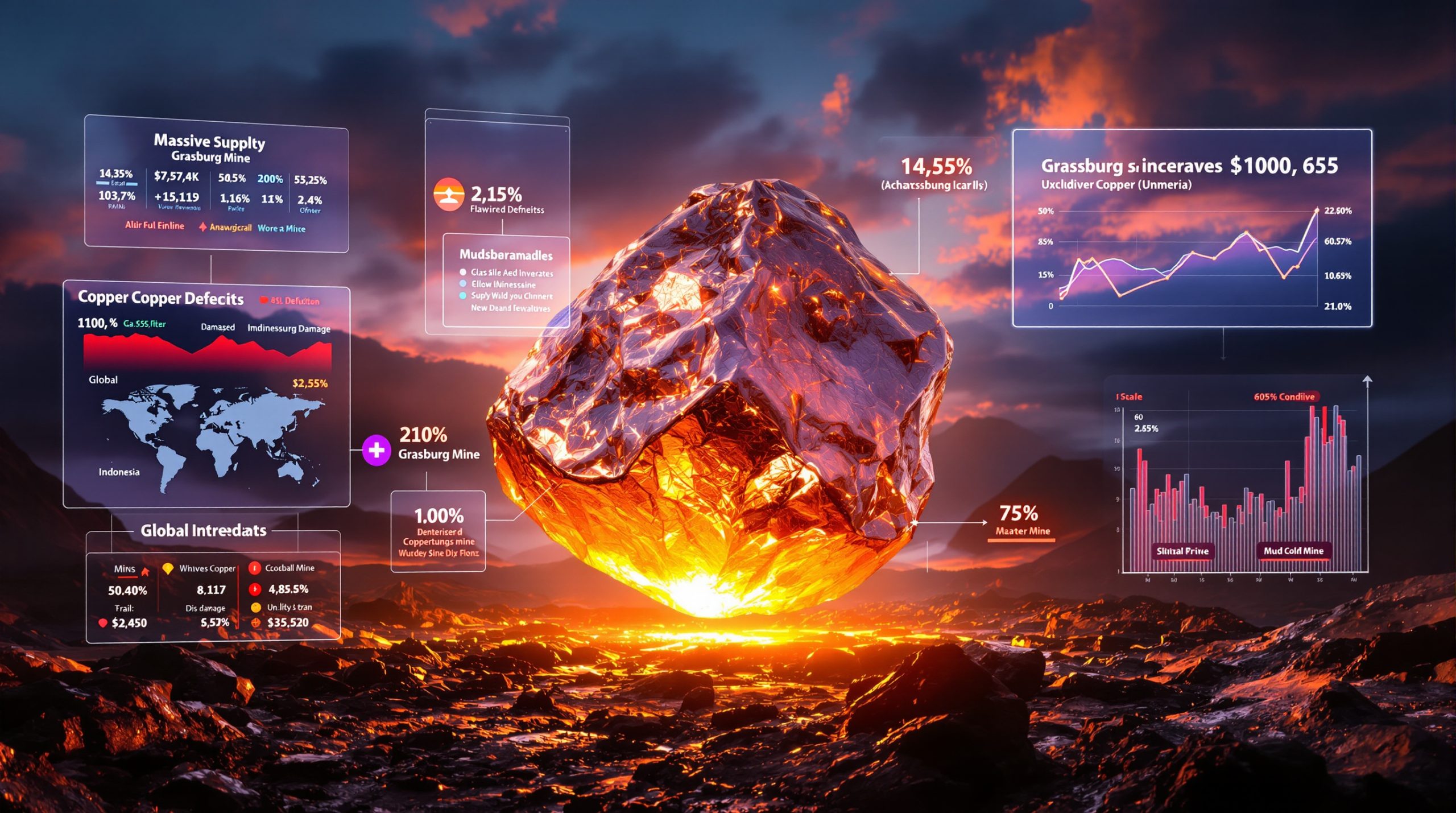How Did the Grasberg Mine Accident Happen?
The catastrophic mudslide at Freeport-McMoRan's Grasberg mine on September 8, 2025, has significantly impacted global copper markets. Operations at this critical facility, which ranks as the world's second-largest copper mine, were immediately suspended following the deadly incident. The disaster triggered an ongoing search and rescue operation for missing workers while necessitating a comprehensive damage assessment process.
The sudden inundation of wet material into the mining area created substantial operational challenges. Extensive cleanup efforts are now running alongside detailed damage evaluations. This unexpected disruption has fundamentally altered the global copper supply outlook for both 2025 and 2026.
Industry experts note that the geological conditions in the region may have contributed to the instability that led to the mudslide, though specific causes remain under investigation as authorities prioritize recovery efforts.
What Makes the Grasberg Disruption So Significant?
Scale of Production Impact
The Grasberg operation represents more than 25% of Freeport-McMoRan's total copper output, making it a cornerstone asset in the global supply chain. Following the accident, the company had no choice but to declare force majeure and substantially reduce its sales forecasts for both 2025 and 2026.
According to Benchmark Mineral Intelligence analyst Albert Mackenzie, "The scale of this disruption is very big." Their analysis reveals the following impact metrics:
| Impact Metric | Estimated Figure |
|---|---|
| Lost Copper Production (Sept 2025-Dec 2026) | 591,000 tons |
| Percentage of 2024 Global Mine Production | 2.6% |
| Global Production Baseline (2024) | ~23 million tons |
To put this in perspective, the 591,000 tons of projected lost production represents enough copper to manufacture approximately 59 million electric vehicles, highlighting the real-world implications of this supply shock.
Market Balance Transformation
The suspension has fundamentally altered market projections from leading financial institutions, shifting the copper market from anticipated surplus to significant deficit:
| Analyst | Previous 2025 Forecast | Revised 2025 Forecast | Change |
|---|---|---|---|
| Goldman Sachs | 105,000-ton surplus | 55,500-ton deficit | -160,500 tons |
| Bank of America | – | 350,000-ton deficit (2026) | +188,000 tons from previous estimate |
| Societe Generale | – | Largest deficit since 2004 | – |
This dramatic shift underscores the fragility of global copper supply chains and the outsized impact that disruptions at major production centers can have on worldwide availability.
How Does Grasberg Fit into the Broader Copper Supply Chain?
Compounding Existing Disruptions
The Grasberg mine accident represents the third major copper mine disruption in 2025, following significant production issues at:
- Kamoa-Kakula mine in the Democratic Republic of Congo
- El Teniente mine in Chile
These combined disruptions have exacerbated an already tight supply situation. According to Bank of America analyst Michael Widmer, 2025's mine supply was already projected to fall below every forecast made over the past 15 years, even before these unexpected disruptions occurred.
The mining industry has faced increasing challenges with declining ore grades at many major operations. While the average copper grade in mined ore was approximately 0.8% globally in the early 2000s, many operations now work with grades closer to 0.5%, requiring more material to be processed for the same copper output.
Global Production Hierarchy
Grasberg's position in the global copper production landscape:
| Rank | Mine | Location | Relative Size |
|---|---|---|---|
| 1 | Escondida | Chile | Largest copper mine globally |
| 2 | Grasberg | Indonesia | Second-largest copper producer |
| 3+ | Various operations | Multiple countries | Significantly smaller individual contributions |
What makes Grasberg particularly valuable in this hierarchy is not just its production volume but the quality of its concentrate. Unlike many operations that produce concentrates with problematic impurities, Grasberg's output typically contains valuable gold credits and relatively few problematic elements, making it highly sought after by smelters.
What Are the Market Implications of the Grasberg Disruption?
Price Response and Projections
The immediate market reaction to the Grasberg accident was dramatic, with copper prices surging to 15-month highs of $10,485 per metric ton in the week following the announcement.
Bank of America has significantly upgraded its price forecasts in response to the tightening supply conditions:
| Year | Previous Price Forecast | Revised Price Forecast | Percentage Increase |
|---|---|---|---|
| 2026 | $10,192/ton | $11,313/ton | 11% |
| 2027 | $12,000/ton | $13,500/ton | 12.5% |
For context, copper's all-time record high was established in May 2024 at $11,104.50 per ton, suggesting the potential for new historic price levels in the coming years. Various copper price predictions indicate we may see unprecedented values as supply constraints intensify.
Market technicians note that breaking through the $11,000 resistance level could trigger momentum-based buying that might drive prices significantly higher, as many algorithmic trading systems have key trigger points around these psychological barriers.
Supply-Demand Balance Shift
The Grasberg disruption has transformed the global copper market outlook from a modest surplus to a significant deficit:
| Period | Previous Market Balance Estimate | Revised Market Balance Estimate |
|---|---|---|
| 2025 | Small surplus | ~400,000-ton deficit |
| 2026 | Small surplus | Mixed (deficit to small surplus depending on analyst) |
This shift occurs against a backdrop of growing copper demand surge from electrification initiatives worldwide. The average electric vehicle requires approximately 80 kg of copper, compared to just 20 kg in conventional vehicles. Meanwhile, renewable energy infrastructure requires up to five times more copper per megawatt than traditional power generation.
How Will the Grasberg Disruption Affect Different Market Participants?
Mining Companies
- Freeport-McMoRan: Faces significant production and revenue losses, potentially in the billions of dollars, alongside substantial reputational impacts and recovery costs
- Other major producers: Likely to benefit from higher copper prices, potentially accelerating expansion plans to capture market share
- Junior miners and exploration companies: May see increased investment interest as supply security concerns grow and higher price forecasts improve project economics
For existing producers, the economics of processing lower-grade stockpiles and previously uneconomic resources may suddenly become viable, potentially adding incremental supply to partially offset the deficit.
Downstream Industries
- Electronics manufacturers: Potentially facing higher input costs and supply chain uncertainties, especially for companies unable to pass through increased costs to consumers
- Renewable energy sector: Possible delays in scaling up production of copper-intensive technologies like wind turbines and electric vehicle charging infrastructure
- Construction industry: Higher costs for copper wiring, plumbing, and other building materials, potentially impacting project timelines and budgets
Companies with long-term copper supply agreements at fixed prices stand to benefit significantly, while those relying on spot market purchases may face considerable cost pressures.
Investors and Market Speculators
- Commodity traders: Increased volatility creating both risks and opportunities, particularly in the futures markets
- Mining equity investors: Potential for sector-wide revaluation based on higher copper price projections, especially for companies with significant production or development assets
- Futures market participants: Changing dynamics in contango/backwardation structures as near-term supply tightens
Historically, mining equities have shown a tendency to overreact to commodity price movements, potentially creating opportunities for investors who can accurately gauge the duration and severity of supply disruptions.
What Are the Long-Term Implications for Global Copper Supply?
Infrastructure Vulnerability Exposure
The Grasberg incident highlights the fragility of the global copper supply chain, where single-point disruptions can have outsized impacts on worldwide availability. This vulnerability is particularly concerning given copper's critical role in:
- Renewable energy transition (solar panels, wind turbines)
- Electrification of transportation (EVs, charging infrastructure)
- Digital infrastructure expansion (data centers, telecommunications)
- Industrial automation (robotics, smart manufacturing)
Risk managers across industries are likely to reassess critical mineral supply chains, potentially leading to greater inventory holdings, diversified sourcing strategies, and increased interest in recycling.
Supply Development Acceleration
The significant market deficit created by the Grasberg disruption may accelerate:
- Development timelines for copper projects currently in the pipeline
- Exploration budgets for new copper discoveries
- Investment in recycling and recovery technologies
- Innovation in copper-alternative materials for certain applications
The elevated price environment could bring forward investment decisions on projects that might have remained marginal at lower prices. For example, deep-sea mining ventures targeting copper-rich seafloor deposits may receive renewed attention, despite environmental concerns.
Geopolitical Considerations
The incident underscores the concentration of copper production in a limited number of jurisdictions, potentially influencing:
- Resource nationalism policies in copper-producing nations
- Strategic stockpiling decisions by major consuming countries
- Trade relationships between producer and consumer nations
- Investment patterns in mining jurisdictions perceived as more stable
Indonesia in particular has been implementing increasingly nationalistic resource policies in recent years, and this incident may accelerate those trends or trigger similar approaches in other copper-rich nations. Meanwhile, the Glencore smelter shutdown in Chile further complicates the global processing landscape, intensifying the supply crunch.
FAQ: Key Questions About the Grasberg Mine Accident
How long will the Grasberg mine remain offline?
While exact timelines remain uncertain, analysts project significant production impacts through the end of 2026, suggesting a recovery period of at least 15 months from the initial incident. The complex nature of the operation, with both open-pit and underground components, complicates the recovery timeline.
Could this accident have been prevented?
Safety investigations are ongoing, but mining in geologically complex regions always carries inherent risks. The full assessment of preventability will depend on the specific circumstances that led to the mudslide, including rainfall patterns, ground stability monitoring systems, and operational procedures.
Will this incident affect other mining operations in Indonesia?
Regulatory responses may include increased safety inspections and requirements across Indonesia's mining sector, potentially affecting operational procedures at other sites. Indonesian authorities have historically responded to mining incidents with enhanced oversight, sometimes extending to temporary shutdowns at other operations.
How will this impact copper prices for consumers?
End consumers will likely see gradual price increases in copper-containing products, though manufacturers may initially absorb some costs before passing them to customers. Products with high copper content, such as air conditioning units, electric motors, and wiring, may see more significant price impacts than those where copper represents a smaller component of overall costs.
What alternatives exist for copper buyers facing supply shortages?
Options include:
- Drawing from strategic stockpiles
- Increasing use of recycled copper (currently about 30% of global copper supply)
- Substituting alternative materials where technically feasible
- Securing longer-term supply contracts with producers unaffected by the disruption
- Implementing design changes to reduce copper intensity in products
Conclusion: A Watershed Moment for Copper Markets
The Grasberg mine accident represents a pivotal event in global copper markets, transforming supply-demand dynamics during a period of already tight availability. The incident's timing—amid growing copper demand for energy transition technologies—magnifies its significance.
As the industry responds to this disruption, market participants across the supply chain must reassess risk management strategies, supply security measures, and price expectations. The Grasberg incident may ultimately accelerate the development of new production capacity while highlighting the vulnerability of concentrated supply chains for critical minerals.
The coming months will reveal the full extent of the disruption's impact as Freeport-McMoRan works to restore operations at this crucial production center, while global markets adjust to the new supply reality. In response, we may see increased focus on US copper investment insight as countries seek to diversify their supply sources away from geopolitically complex regions.
Want to Discover the Next Major Mining Opportunity Before the Market?
Discovery Alert's proprietary Discovery IQ model delivers real-time alerts on significant ASX mineral discoveries, instantly identifying potential investment opportunities before they become mainstream news. Explore our discoveries page to understand how major mineral finds have historically generated substantial returns for early investors.




